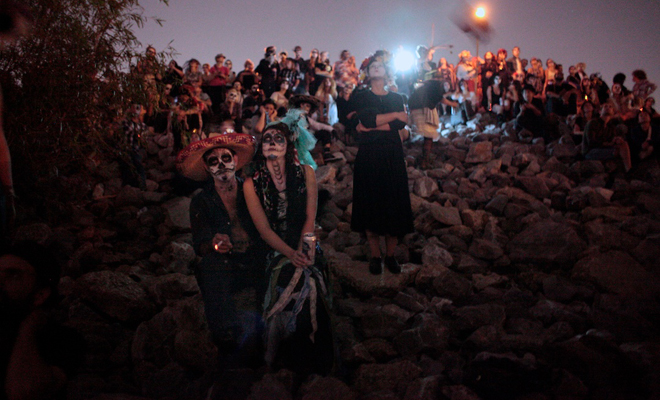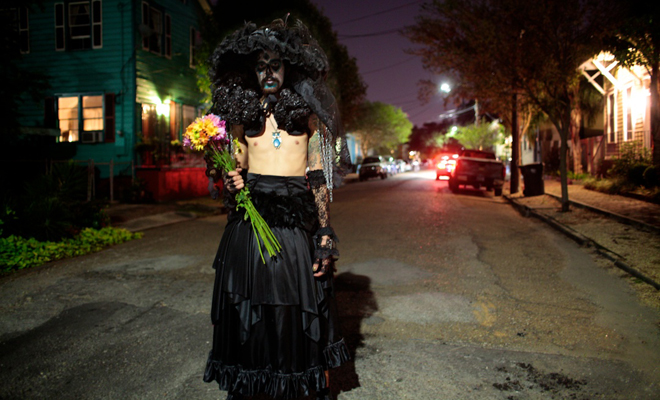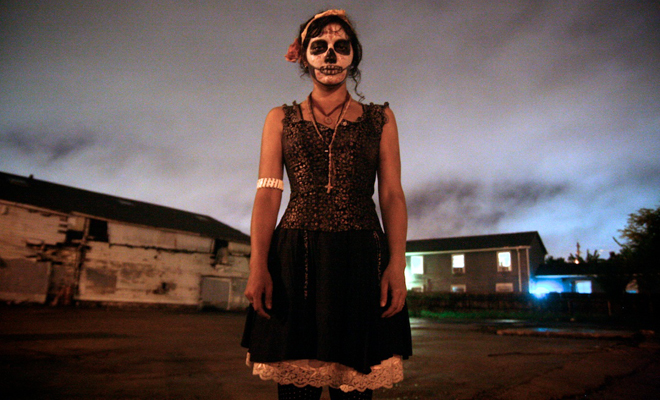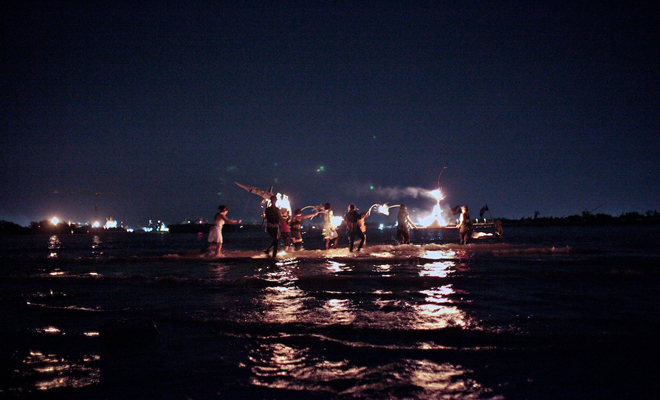On Being (In)Visible

The Day of the Dead parade eventually stops at what is locally known as “The End of the World.” Photo by Sarrah Danziger.
The role of the “public,” if not passive at least a walk-on, must ever diminish, while the share of those who cannot be called actors but, in a new meaning of the term, “livers,” will increase. – Guy Debord[i]
Editor's Note
December is already upon us! As you begin to wind down your year or your existence (depending on your predilection for apocalypse), Laurence Ross remembers last month's Day of the Dead parade.
By the time I arrived at the gathering of the living/dead, the Bywater twilight (and the fact that I was not wearing my glasses) had distorted the scene. There was the droning of accordions, the drinking of beer, the train tracks—the notes, the acts, the atmosphere intentionally being blurred. Hundreds of people were clustered in groups, the already-adorned adorning still others in skeletal face paint. This is the nature of dusk—that one is simultaneously wearing a mask and not, that the paint and the dark are simultaneously a part of the face while obscuring it. Friends search for friends as light and the capacity for recognition dim.
The Day of the Dead is a finishing of sorts, a time to remember those in the past year that have been lost. The day is not so much the tying of a knot, but the untying of one. A release, a letting go, a setting free. Who, exactly, is remembered is a more individual matter—for some, quite private. Photographs and flowers, letters and trinkets. Artifacts accumulate on altars and anecdotes are shared. “My grandmother,” “my friend Jason,” “Whitney Houston.”
This collection of acts is undeniably ritualistic, a type of spiritual, an entity not prone to criticism—at least criticism in the sense that criticism is often thought of as judgment. Peter Bürger, in his attempt to draw distinctions among sacral art, courtly art, and bourgeois art, posits, “Sacral art is part of the life praxis of the faithful. Yet the detachment from the sacral tie is a first step in the emancipation of art.”[ii] As the ceremonial participant draws and thickens a black line to accentuate and define a jawbone, the critic also strives for a type of definition, pressing upon and agitating the line between ritual and art. Does the critic necessarily emancipate himself from the practice of art? He is oftentimes found quite literally in his own way—blocking himself from being part of the whole, from being wholly “present.” While the chanting/singing/flag-swinging/horn-playing perpetually exists in the first person, the “now,” the critic’s presence is detached, is spectator, spectral, ghostly (and to some, of course, ghastly). The critic, after all, exists on a different spiritual plane and often moves about unseen and unheard. (But here I am.)

A participant in the Day of the Dead parade proffers flowers in remembrance. Photo by Sarrah Danziger.
Bürger goes on to say, “An art no longer distinct from the praxis of life but wholly absorbed in it will lose the capacity to criticize it, along with its distance.” In other words, if we fully return art to the realm of ritual, there is no criticism—at least not inherent in the ritual itself. Therefore, if criticism were to emerge (as it does here), the implication is that the critic is inherently not “a part” of the art, but instead “apart” from the art. Criticism is a level of remove—it is a perspective that demands distance. And if, as Oscar Wilde infamously suggests, criticism is in and of itself a mode of artistic expression, and if the object of that criticism is the praxis of life, then that criticism—removed from that praxis—is necessarily other-than-life. That criticism, in its distance, is (a type of) death or, at the very least, a purgatory realm of the walking, wakeful dead.
I heard about the Day of the Dead parade by word-of-mouth from a friend who had also heard of the event word-of-mouth the year before. That year, my friend had gathered with a mass of friends and strangers with faces painted as skulls, dressed in black, clutching withered bouquets. The funereal procession had marched to the sound of drums and brass, to remember those who had passed.
My friend’s memory, however, is not so sound. After whiting out our faces and blacking out our eyes this year, three of us walked to the gathering spot. But come twilight, there was no gathering. We stood in a vacant lot, which, at that moment, seemed somehow all the more vacant—vacant not simply in the sense of empty space, but vacant in the sense of a void, a vacuum, an absence of what we had expected to be present. As memories (and memorials) fail us, we had gotten it all wrong. We had been a day early, a trio of outcasts, the memory a literal miss-fit of fragments and fact.
This confusion seems an inescapable consequence when dealing with the underground/underworld. To be advertised would solidify an overarching organizing body—an entity/author that, if it did exist, did not make itself visible. The author of the Day of the Dead parade, if not dead, was deeply buried. Were he to be leading the march with his (however metaphoric) baton, the event would be decidedly different. The event, to some extent, would be more decided. As Roland Barthes says of the author’s influence, “To give a text an Author is to impose a limit on that text, to furnish it with a final signified, to close the writing.”[iii] Given the sacral nature of the event, to furnish too rigid a structure would be an affront to the individual. To close the event would be to take away one’s ability to take away what one will. It would suppress the public will, the public’s agency in the event, the public’s own (participatory) intention. Barthes argues, “The birth of the reader must be at the cost of the death of the Author.” To birth the reader is to give life to the reader, or, in regard to the parade, to yield agency to the public/spectator. The public/spectator is able to transcend the outlined form and become participant/spectacle—to become, as Debord terms them, “livers.” In order for us to pay our respects, to offer our offering to the altar (and to the parade itself), the author must be written out of the line.

A participant in the Day of the Dead parade has adorned her face in skeletal face paint. Photo by Sarrah Danziger.
A parade is inherently its own line. Or, rather, a generalized direction. Parts/people will break off, take a child home, search for a bottle of whiskey, or simply tire. The parade generates a human exhaust(ion) in which, in the subatomic world of the event, a particle, an ion, a participant, an infant, drifts away into the dark like smoke from the fire. Just as in physics, those drifting participants matter. Their (physical) matter is not lost, but simply taken out of sight—no longer staged because no longer viewed. Participants are, of course, free to leave because (in that present/parade/performance) there is no intended framework. There is no artist setting the frame.
Yes, there were clearly smaller groups within the larger that had intentions: the construction of a portable altar, synchronized flag bearers, a marching band, the large float of a reptile skull and vertebrae weaving through the crowd with movements similar to a Chinese dragon dance. But even these small collective bits of organization were open to the improvisation that participation assures. As I attempted to take in my surroundings, to observe, a woman approached me to ask if I would like to be a vertebra.
What, exactly, is the skeletal structure of an event such as this? As Umberto Eco says about the musician playing a piece of work, “All this amounts to an act of improvised creation.”[iv] But even Eco’s musician has sheets of music written by a composer to guide him. How do we “play the music” of the Day of the Dead? There are notes we all seem to follow: fireworks and lace, candles and bouquets, hats and veils. But because we, the players, make choices and decisions, we do not fully occupy either the role of spectator or the role of spectacle, but instead occupy a realm straddling the two worlds. The parade eventually stops at what is locally known as “The End of the World”: a spot along the river bend, a precipice with a steep rocky decline toward the Mississippi. On the banks, the reptile skeleton was first set afire then set adrift among the waves, flames visible until they were not, and even that skeletal structure of recognition dissolving.
On the notion of a permeable artistic structure, Eco says: “In this general intellectual atmosphere, the poetics of the open work is peculiarly relevant: it posits the work of art stripped of necessary and foreseeable conclusions, works in which the performer’s freedom functions as part of the discontinuity which contemporary physics recognizes, not as an element of disorientation, but as an essential stage in all scientific verification procedures and also as the verifiable pattern of events in the subatomic world.”
Was there anything of science present at the Day of the Dead?
An altar is a stage for a collection of mementos, personal relics that create a constellation of massed meaning without needing (or having the capacity) to name each individual star. Though some stars may be larger, brighter, glitter more, catch more light, each is still a piece, regardless of how dull it/he/she/they may seem. Some, hardly noticed. Some invisible to some. It is the critic who creates the pattern/meaning/interpretation, the story/setting/frame to convey to those who were not there, there seeing just exactly what the critic saw. The critic is astronomer and intermediary. The critic resides in the in-between.
Perhaps it is occupying this boarder space of the veil, neither on this side of the dirt nor the other side of the sky, that makes the author of the work (and also the critic) so obscure, so absent. The End of the World is a border that was rendered all the more metaphorically apt when a cargo ship named Born Again swept its bright white spotlight across us. While the ship was not authored, she was certainly captained. And whether Born Again meant to resonate or not, she did become a piece of a larger pattern. At least for me.

A float of a reptile skull and vertebrae weaved through the crowd and was later set afire then set adrift. Photo by Sarrah Danziger.
References:
[i] Guy Debord, “Towards a Situationist International,” 1957.
[ii] Peter Bürger, “The Negation of the Autonomy of Art by the Avant-Garde,” 1984.
[iii] Roland Barthes, “The Death of the Author,” 1967.
[iv] Umberto Eco, “The Poetics of the Open Work,” 1962.
Editor's Note
To view more images from the Day of the Dead parade, visit www.sarrahdanziger.com.



